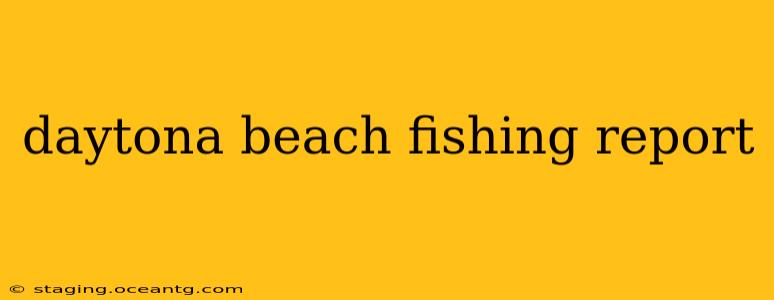Daytona Beach offers a diverse range of fishing opportunities, from inshore flats to offshore reefs. Whether you're a seasoned angler or a casual caster, this report will provide you with up-to-date information and insights to help you plan your next fishing adventure. We'll cover the current conditions, popular catches, and some helpful tips to maximize your success.
What's biting in Daytona Beach right now?
This is the million-dollar question, and the answer constantly shifts based on the time of year, water temperature, and recent weather patterns. Currently, [insert current date] reports indicate strong catches of [list prevalent species - e.g., redfish, speckled trout, flounder, etc. Be specific about location if possible - e.g., "Redfish are biting strong in the Ponce Inlet area,"]. Offshore, [mention offshore catches - e.g., mahi-mahi, king mackerel, tuna - again, with location specifics if available]. Remember to check with local bait shops for the most up-to-date information; they're often a great resource for real-time fishing conditions.
What are the best fishing spots in Daytona Beach?
Daytona Beach boasts a variety of excellent fishing spots catering to different preferences and skill levels.
Inshore:
- Ponce Inlet: Known for its diverse fish population, Ponce Inlet offers opportunities for both surf fishing and boating access to deeper waters. Look for redfish, snook, and tarpon in the inlet itself.
- Daytona Beach Pier: A classic fishing spot, the pier provides easy access for anglers of all skill levels. Expect to catch whiting, pompano, and other smaller species.
- Mosquito Lagoon: Accessible by boat, Mosquito Lagoon offers fantastic opportunities for backcountry fishing. Redfish, trout, and snook are common catches here.
Offshore:
- The "Ledges": This area, a few miles offshore, is known for its excellent bottom fishing. Expect to find snapper, grouper, and other reef fish.
- The "Gulf Stream": For those willing to venture further out, the Gulf Stream offers pelagic fishing opportunities. Here, you can target marlin, tuna, and mahi-mahi.
What kind of bait and tackle should I use?
The best bait and tackle will depend on what you're targeting. For inshore fishing, live bait like shrimp, mullet, and pilchards are highly effective. Artificial lures, such as jigs, spoons, and topwater plugs, also work well. Offshore fishing often requires heavier tackle to handle larger fish. Trolling lures, such as ballyhoo and skirted lures, are commonly used for pelagic species. Consult with local tackle shops for the most current bait and lure suggestions.
What are the fishing regulations in Daytona Beach?
It's crucial to familiarize yourself with Florida's fishing regulations before heading out. These regulations specify size and bag limits, as well as seasonal closures. Always have your fishing license readily available and ensure you're complying with all applicable rules and regulations. You can find detailed information on the Florida Fish and Wildlife Conservation Commission (FWC) website.
What is the best time of year to fish in Daytona Beach?
Daytona Beach offers year-round fishing opportunities, but certain times are better for specific species. Spring and fall generally provide excellent conditions for many species, while summer can be hot and produce more challenging fishing. Winter can offer calmer seas for inshore fishing, but some species may be less active. Research the target species' preferred water temperature for optimal results.
Are there any guided fishing charters available in Daytona Beach?
Yes, several guided fishing charters operate in Daytona Beach. These charters can provide experienced captains, boats, and tackle, making your fishing trip more convenient and successful. Searching online for "Daytona Beach fishing charters" will yield various options to suit your needs and budget.
What should I wear when fishing in Daytona Beach?
Dress appropriately for the weather conditions and the type of fishing you'll be doing. Sunscreen, sunglasses, and a hat are essential, even on cloudy days. Comfortable, non-slip shoes are also a must. If you're fishing offshore, consider wearing layers to account for changing temperatures.
By following these tips and staying informed about current fishing conditions, you'll significantly increase your chances of having a successful and enjoyable fishing experience in Daytona Beach. Remember always to practice responsible fishing, respecting the environment and adhering to all regulations. Tight lines!
